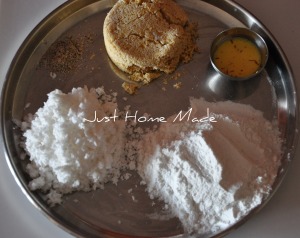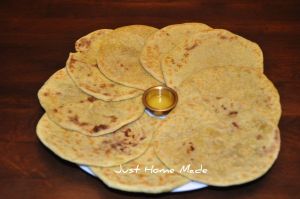Maavizhakku [Maav viLakku]; Maavu – Flour, ViLakku – oil lamp with a wick, which literally means an oil lamp made of flour in Tamil.
It is a sweet dish prepared especially on a PurattAsi (Perataashi) Shani kizhamai i.e, a Saturday in the PurattAsi month of the Tamizh calendar, as an offering “Naivedhyam” [Nai vay dyum] to Lord Srinivasa, PurattAsi Shravanam being his birth star. Time and all else permitting, this ritual can be performed on all the four Saturdays of that month, if not, at least on two Saturdays either the 1st and 3rd or the 2nd and 4th. I was able to observe the ritual neither on the 1st, 2nd nor the 3rd Saturday and hence performed the ritual with two Maavilakku’s on the 4th or last Saturday as per elder’s suggestions.
My earliest memories of “Maavilakku” are that of watching my aunt Ve [Vay] religiously and devoutly create them on all the Saturdays of that month, during my growing up years at my taatha’s (maternal grand dad) place. In orthodox Iyengar families like my Taatha’s, the procedure to prepare Maavilakku was rather uncompromising due to reasons of “Madi” and hence consisted of starting from scratch with soaking rice in water for a few hours, then lightly dried, pounded with a wooden food pounder and repeatedly sieved to derive the rice flour of the required consistency. Now-a-days, self confessedly, such rigorous care is not possible for most of us and therefore, I have simply started with ready- made rice flour.
Similar forms of this sweet aka “Tambittu” [ Thum bit too] are prepared in Karnataka among several other sects of brahmin communities too, may be on a different festive occasion like Mangala Gowri Vrata or Shivaratri.
Things you’ll need:
The ingredients listed below make for a medium-sized lamp or two small lamps. If you need to increase the quantity, just make sure to add equal proportions of Rice flour, Jaggery and grated coconut.
- 1/2 cup Rice flour
- 1/2 cup Jaggery mashed / grated
- 1/2 cup grated coconut
- 4 cardamom powdered
- a pinch of Saffron
- 1 tbsp milk (for the saffron to leave color)
- 2 – 3 tbsp Ghee
- Mix together in a bowl, grated coconut, jaggery and powdered cardamom and set aside for 15 mins so the jaggery melts and blends in.
- Warm up the milk – either microwave or keep in a bowl of hot water and soak the saffron for 10-15 mins until it leaves color.
- Add in the rice flour, saffron milk and 2 tsp of ghee to the coconut jaggery mixture and mix well. Do not add any more milk or water to this.
To offer prayers:
- Shape the dough into a small hill with a shallow pit at the top and part it in the middle.
- Place two cotton wicks in the left partition and wet them with ghee. Pour the remaining ghee in the right partition.*
- Light the cotton wicks and offer prayers to Lord Venkateshwara.
- Wait for the light to subside on its own. The “Maavu” can now be distributed as Prasadam or on a pair of betel leaves and betel nuts (in pairs) aka “Tambulam“.
 * When posed with my questions, my dear aunt Ve would explain that the left side (to you when facing the God) with the lamp lit in it signifies Lord Srinivasa himself and the right side with the ghee symbolizes goddess Lakshmi and the shape of a hill signifies the Tirumala hill itself.
* When posed with my questions, my dear aunt Ve would explain that the left side (to you when facing the God) with the lamp lit in it signifies Lord Srinivasa himself and the right side with the ghee symbolizes goddess Lakshmi and the shape of a hill signifies the Tirumala hill itself.
More details on the Whys and How’s of this ritual can be found here and here.
Tips & Warnings:
Optionally Pacchakarpooram (not the camphor used for MangalArati) can also be added to prepare the Maavilakku. However, my personal experience forces me to caution against using it unless you are aware of its effects when used in larger quantities. In any case, if you are still tempted to use it, the size of a mustard or two is more than enough for the quantities given in my recipe.







